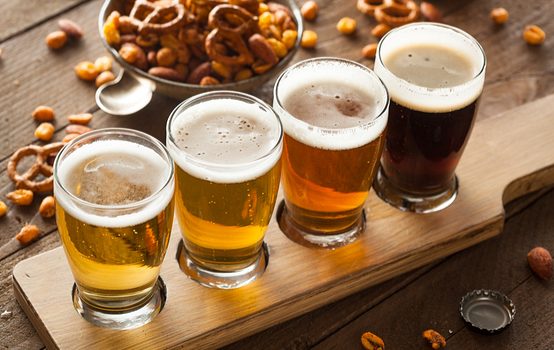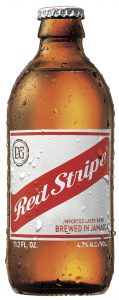Brewmaster is the third-best job title in the world. “The first is astronaut,” says Garrett Oliver, the brewmaster for Brooklyn Brewery since 1994. “The next is quarterback. But after that comes brewmaster.”
One thing that’s exceedingly clear to the group visiting Brooklyn Brewery during the Fast Company Innovation Festival is that Oliver is very good at his job. They are held rapt as he recounts stories of trekking to warehouse parties back when cabs wouldn’t go to Williamsburg; the history of industrialized food production; the rise, fall, and rebirth of craft brewing in the United States; and the merits of the Rolling Stones versus Elvis Costello. Oliver knows how to thread a narrative about the intersection of creativity and entrepreneurship—the lifeblood of Brooklyn Brewery.
From its beginnings in a Brooklyn apartment, the brewery founded by Steve Hindy and Tom Potter has since grown into a brand synonymous with craft beer. The company—which is the 12th-largest craft brewer in the U.S. by volume—now generates 50% of sales overseas and recently sold a 24.5% stake to the Japanese company Kirin to help fund ambitious expansion plans in Asia and South America. It’s also inked a deal to build a sprawling 77,000-square-foot facility in the Brooklyn Navy Yard. It’s one of thousands of businesses in the growing $20 billion craft beer industry, but it has separated itself from the pack by growing big while retaining the cachet of an artisanal small company.
Here’s how.
Today, there are over 4,000 breweries in the U.S., but that wasn’t the case when Brooklyn Brewery began in the late 1980s. There were about 150 total, according to the Brewers Association.
“In the United States, beer became part of what I’ll refer to as the ‘Matrix,'” Oliver says. A postwar rise in processed food and national distribution networks of industrially produced comestibles eventually changed America’s eating habits. Out was fresh, homemade food and in was Wonder Bread. “You look at the [ingredients on the package] and it’s a list of chemicals and you don’t know what they are—that is the Matrix and it didn’t just happen to bread, it happened to cheese, to ice cream, and to beer. The trick of the Matrix is to make you forget about reality. Once you don’t know what the beer is anymore, you forget what it tastes like. When you’re offered a false version, you don’t even know what the original was.”
Most of the beer consumed in the country was the bland, watery, and golden variety advertised during major sporting events. When Brooklyn Brewery launched its inaugural beer in 1998—the malty, deep amber-brown Brooklyn Lager—it looked nothing like what beer drinkers were accustomed to.
“They didn’t even want to know about it—they asked, ‘Why is it dark? What does that mean? Something must’ve happened to it’,” says Oliver. “‘What is that smell? Why is it so bitter?’ We had to create the demand for people to come ask for the beer.”
Brooklyn Brewery hired the ace graphic designer Milton Glaser to create a strong brand and identity, then the company built its own distribution network to get its product into bars and stores. The company, which relies on word of mouth and doesn’t take out traditional ads, also donated beer to events, like gallery openings, to build the brand and its consumer base.
Today, the company produces over 250,000 barrels of beer and about 35 different varieties, some of which are available year-round, seasonally, and in very limited runs. When Oliver thinks up new recipes, he takes on the guise of a mad scientist in a lab, trying experimental concoctions like brewing beer with citrus and mace and aging it in old bourbon barrels to riff on a cocktail. The end result? The Improved Old Fashioned. Or taking a funky sour ale and aging it with raspberries to make a beer called The Discreet Charm of the Framboisie.
To come up with these ideas, Oliver uses the metaphor of a creativity pyramid. And he wants to be at the top. “The bottom of the pyramid is like a chef teaching you how to make an omelet and you make the exact same omelet—you’re able to create somebody else’s thing, and that’s the lowest level,” he says. He then explains:
From there, you have an elaboration of that omelet. The chef told you how to make a cheese omelet, but you made a cheese omelet with onions and spinach. That’s a little bit of creativity, a twist. Then the next level you have combinational creativity. You take two or three things and put them together in an unexpected way. You decide to cover bacon with chocolate. Above that is a level where you’ve created a truly brand-new and inventive dish with various parts to it that no one’s seen before. But at the top is where you develop a technique that’s so powerful and transformative that it could inform 1,000 recipes. A version of this would be Ferran Adrià and his team learning how to stabilize culinary foam.
Brooklyn Lager is the beer that built the brand, but Oliver doesn’t rely on its equity to keep the company’s momentum building or think that it embodies what the brewery stands for. It’s about staying fresh and creative. “Brooklyn Lager is the sun in the center that everything revolves around,” he says. “It’s the album that every college kid buys and says, ‘That is the most awesome thing ever,’ and plays it to death. And we’re very, very grateful for that. It’s awesome. But when I get on stage, I’m not going to play the whole damn album. For me, that was 26 years ago, and I’ve moved along. We’re not the Rolling Stones; we’re Elvis Costello.”
Recognizing that there’s a continual need for new ideas (read: new beers), Oliver steers clear of noise and prefers to rely on his own palette and trust his own judgment to guide the recipes and collaborations upon which Brooklyn Brewery embarks. Says Oliver:
We do not ask people questions about what they think we would do and what they think we should make. I am a human being and I am running a business, so I do care whether or not people like our beer, but not while I’m creating the beer. I worry about that later. The only thing that matters to me when I’m making beer is whether I like it. In that moment, whether or not I think you’re going to like it in the future becomes irrelevant to me. Does this make me happy? Would I like to drink it again? Those are the things I’m thinking about.
Have a unique point of view and stick with it. “I tell a number of brewers, the only thing you think you can do better than everyone else, go out and do that,” he says. “The light shining out of your eyes should blind people. They shouldn’t even be able to look you in the eye because you should be on fire all the time. And if you don’t have that, please don’t show up here with your product, because that’s a waste of time.”
Before Oliver was a brewmaster, he was a filmmaker. People often ask him how he made that transition. “They’re exactly the same job,” he says “It’s half art and half science.” This right and left brain approach is what guides his work at Brooklyn Brewery and how the company approaches developing new beers.
“If you get all science and no art, you get a Jerry Bruckheimer summer blockbuster,” Oliver says. “On the other hand, you see some student films that are a total mess because they don’t have the chops. So it’s about having something to say and the ability to say it. Those things in balance are the key to this and to most arts . . . With industrial breweries you have science, but there’s no soul, so there’s no reason to drink the beer.”
Genuine enthusiasm is another of Oliver and Brooklyn Brewery’s creativity- and business-building secrets.
It’s important to me that everything we do every day has to be fun. If you’re talking to people and you’re faking it, they can tell. They’re going to see through you. We’ve made an attempt in everything we do—in the beer, in the way we put ourselves out in public—to brew the truth as I understand it, and I think people can feel that. The realness of what we do as we get out there in public is palpable to people.
That’s part of the overall Brooklyn heritage, making things by hand, artistry, and culture, etc. That’s been part of what makes Brooklyn, a place, a brand unto itself. People say to us, you got the name Brooklyn, what a smart idea. In 1988, that was not exactly a smart idea. Even in the late 1990s, Williamsburg wasn’t a place cabs would take you. People forget the hipness quotient has only come in the last few years, but with that having happened, we get to be a progenitor of it and also a beneficiary.
So far, this strategy has paid off for the company as it expands globally with its local identity.
“While I was traveling in Brazil last year, a journalist came up to me and said, ‘You’re like Mickey Mouse,'” Oliver quips. “I said, ‘I don’t know how to take that.’ He says, ‘Everyone just wants a hug and a selfie.’ That’s kind of nice.”
The Secrets To Creating A Lasting Buzz For Your Brand






